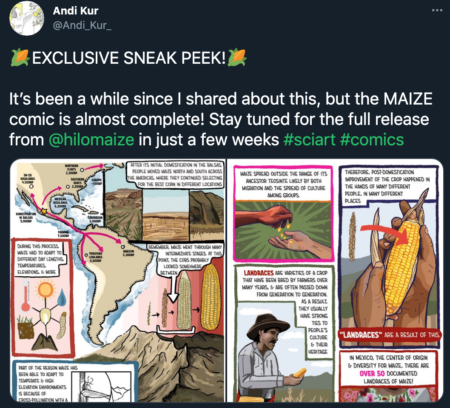- How people used cereals before agriculture in the Fertile Crescent (roughly speaking).
- Fast forward two thousand years and meet Elba, the shepherdess of Courel. And some aurochs.
- Nine thousand years later, MusaNet revamps its website…
- …and coconut revamps its conservation strategy.
- And finally, here are some post-agricultural tomatoes.
Maize comic in the offing
Well this looks super-cool.
Nibbles: Linguistic diversity, Filipino rice, Cashew, Brassica domestication
- The need to save languages.
- Saving rice diversity in the Philippines.
- Cashews saving farmers in Guinea-Bissau.
- Understanding Brassica rapa diversity in order to save it.
Nibbles: Apples, Millets, Miniatures, Transhumance, Ag origins, Seeds
Brainfood: Agroecology, Bioinformatics, Brazilian cassava, Cypriot wine, Swiss poppies, Pollinators, Groundnut breeding, Sorghum pangenome, Crop origins, Sparing vs sharing, Language diversity, Watermelon origins
- Crop origins explain variation in global agricultural relevance. What explains which crops are most important globally? For seeds, an origin in seasonally dry regions. For root, leaf and herbaceous fruit crops, an origin in the aseasonal tropics. But if you account for all that, basically age.
- Linguistic diversity and conservation opportunities at UNESCO World Heritage Sites in Africa. There’s a correlation between linguistic and biological diversity. Has anyone done crop diversity and languages?
- Sparing or sharing land? Views from agricultural scientists. If you look at synergies between nature and nurture (as it were), and beyond crop yield, you realize it’s the wrong question.
- Can agroecology improve food security and nutrition? A review. Yes, in 78% of 55 cases. But will it scale? And does it need to? Anyway, at least it’s looking beyond yield.
- Global effects of land-use intensity on local pollinator biodiversity. Intensification is bad for pollinator biodiversity for most land uses, but cropland intensification is only bad in the tropics. Can’t help thinking this needs to be mashed up with the above.
- Crop breeding for a changing climate: integrating phenomics and genomics with bioinformatics. In particular, integrating the phenomics and genomics of landraces and wild relatives at the extremes of habitable ranges. Well, there’s a lot more to it than that, but this is what stuck with me.
- Comprehensive genotyping of a Brazilian cassava (Manihot esculenta Crantz) germplasm bank: insights into diversification and domestication. 54% duplicates out of 3354 clones, the remaining 1536 arranged in 5 ecoregional ancestral groups.
- A chromosome-level genome of a Kordofan melon illuminates the origin of domesticated watermelons. Not from southern Africa after all. Nice bit of work.
- Preliminary investigation of potent thiols in Cypriot wines made from indigenous grape varieties Xynisteri, Maratheftiko and Giannoudhi. Cypriot grapes are more drought tolerant than varieties grown in Australia, but produce the tastes Aussie wine drinkers really like.
- A morphometric approach to track opium poppy domestication. Fancy math says Swiss Neolithic farmers were involved in the domestication of the opium poppy. Enough to drive one to drink.
- Registration of GA-BatSten1 and GA-MagSten1, two induced allotetraploids derived from peanut wild relatives with superior resistance to leaf spots, rust, and root-knot nematode. Sequencing paying off.
- Extensive variation within the pan-genome of cultivated and wild sorghum. Sorghum next?
